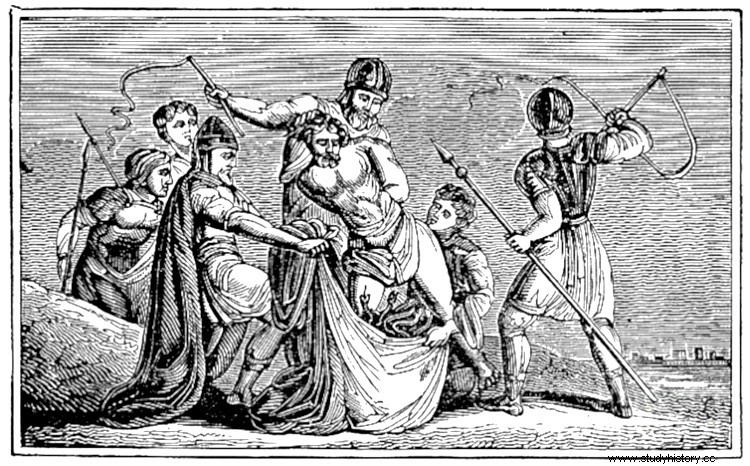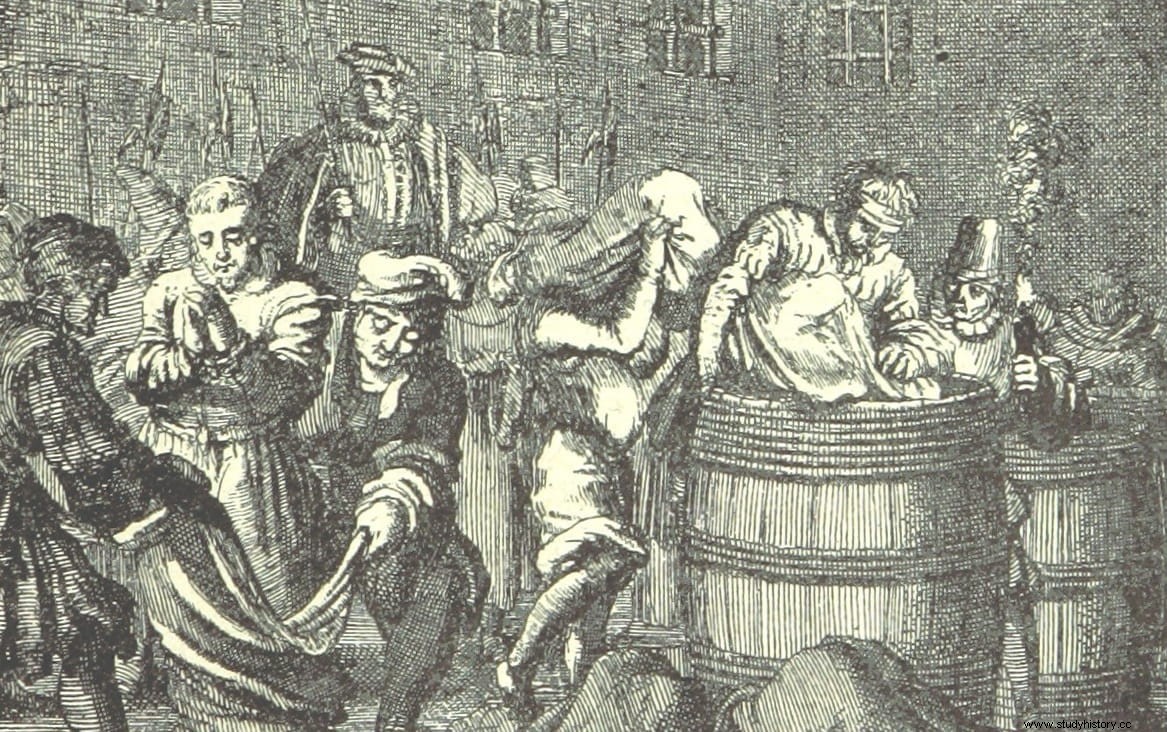Throughout history, from his beginnings to the present, Man has shown an extraordinary imagination to invent penalties and sentences. And, regardless of their level of civilization, some peoples achieved a special degree of refinement. This is the case of the Romans, one of whose forms of punishment is striking due to the bizarre nature of its implementation. This is the one intended for parricides, in which the prisoner was placed in a sack with several live animals and thrown into the water:the poena cullei .
Expanding on the above, the German philosopher Erich Fromm said that we are «the only animal that delights in doing harm to its own species without a rational benefit of a biological and social type» . But sometimes there was -and still is- a moral pretext:the defense of society. Aristotle himself affirms in his work Politics that the most necessary public position is that of jailer, while Pío Baroja, through the mouth of a character in his novel The fight for life , equated the office of executioner with those of priest, soldier and magistrate, as supports of society.
In this sense, parricide was considered a particularly infamous crime in ancient Rome (and earlier in Greece, as evidenced by the myth of Oedipus or the harshness with which Solon treated him), where the character of Tulia the Minor she was a figure of inauspicious memory. Like almost everything in the monarchical stage, history and legend intersect and there remains a mestizo narration of how the youngest daughter of the sixth king, Servio Tulio, not only participated in the conspiracy to assassinate her father and get her second husband, the future Tarquinius the Superb , ascended the throne, but also defiled her corpse by passing over her with a chariot.

It must be understood that the Roman family was the basic cell of society; it was a broad institution that brought together consanguineous members, but also adoptees and even servants, and it was under the absolute authority of the paterfamilias , whose patria potestas it allowed her to dispose of the lives of all those dependent on her. Therefore, killing him was revealed as a heinous act personally, but also socially and the state had to act accordingly. The Lex duodecim tabularum (Law of the XII of Tables) defined parricide as the voluntary homicide of parents by children.
But that corpus Legislative was made in the middle of the 5th century B.C. and, over time, the section referring to this type of crime was expanded. For example, Lucius Cornelius Sulla, consul between 88 and 80 B.C. (with a period of dictatorship from 81 to 80 BC), extended the possible responsibility to other relatives besides the offspring. And the Lex Pompeia de parricidiis , established by Pompey in 55 BC, did the same with potential victims, going from just parents to also stepparents, grandparents, siblings, uncles, spouse, cousins, in-laws, sons-in-law, daughters-in-law, stepchildren, and even employers.
Those who fell outside these categories were governed by the general Lex Cornelia de sicariis et veneficiis , which remained almost unchanged since the XII Tables and punished murder with exile. Likewise, according to Herenius Modestino (a Roman jurist of the 3rd century AD), by the Lex Pompeia could be accused of parricide in reverse, that is, parents who murdered their children, grandparents who did it with their grandchildren or even anyone who bought poison with the intention of ending the life of their parent, although then I didn't get to do it.

Once the crime is clarified, how does the corresponding punishment arise? It is possible that the origins of the poena cullei date back to the monarchical period. Reigning Tarquinius the Proud , one of the duumviri sacrorum (priests) appointed to guard the Sibylline Books Marco Atilio revealed some of his secrets. That was sacrilege because these books were an anthology of prophecies dictated by the Sibyl of Cumae and were consulted every time Rome faced a difficult situation to find possible solutions, so they were banned from the public. Consequently, Atilio was sentenced to be thrown into the sea inside a sewn sack.
Now, what does that have to do with parricide? Nothing really, except that we believe Dionysius of Halicarnassus, according to whom Atilio was also convicted of parricide. Other authors think that he simply took advantage of that way of executing later because his extravagant character was good to exemplify. Plutarch places the date after the Second Punic War and gives the name of Lucius Hostius as the first documented parricide in Rome, although he does not explain how he was executed; Before, the death of a father at the hands of his son would be considered one more homicide, generically.
When this type of crime began to be given a differential category, the atavistic method of handing over the culprit to the family of the deceased would have been resorted to; but since it was the same, it became necessary to also devise a different punishment. That must have started towards the end of the 3rd century BC; according to some historians, perhaps due to the social disorders that occurred among the Romans as a result of the invasion of the Italian peninsula by the Carthaginian Hannibal. They even believe they see in certain passages of Plautus, at the beginning of the following century, humorous references to the introduction of the poena cullei .
Of course, Marco Atilio was not the only one to go down in history dying in such an ignominious way. Plutarch also reviews the case of a certain Cayo Vilio, who was condemned for having supported the reforms of the Gracchi and who was executed by being locked inside a vase with snakes inside. A variant that preceded in a few decades the one that Tito Livio is considered to be the first to suffer execution for parricide in the way that would last in the future:Publicio Maleolo, who having been found guilty of murdering his mother back in 100 BC,, he was sentenced to be put inside a closed sack and thrown "into a stream of water" .
The case of Maleolo is described by various sources and none mentions that animals were also introduced with the prisoner, which confirms the current belief that this was a later addition of the first imperial stage. The description that can be read in the Rhetorica ad Herennium (Rhetoric to Herennius, an anonymous philosophical treatise dated to about 90 B.C.), it does provide other details, such as Maleolus having a wolf-skin bag covered over his head and wearing soleae lignae (clogs or wooden shoes), objects that were intended to isolate the guilty party from the world.
However, Cicero (to whom the Rhetoric to Herennius was wrongly attributed) for a long time) objects in his De inventione that the head bag was made of simple leather, perhaps a wineskin. He is an interesting author because he speaks several times about the poena cullei in his writings. For example, in the vibrant speech with which he defended Sextus Roscius from the accusation of murdering his father (in reality it was a personal revenge in which Roscius himself almost died after his father), Cicero criticized the system of execution... and, by the way, he obtained the acquittal of his client.
Suetonius says that it was Augustus who formally authorized the poena cullei , although in practice it was already applied, as we have seen, and since then it has become habitual; so much so that, according to Seneca, in the times of Claudius they saw “more sacks than crosses” , from which it would be necessary to deduce that parricides proliferated. That parricide had become more frequent than desirable has its icing on the cake in Agrippina's death at the hands of her son Nero.
Suetonius attributes to the emperor the death of her young lover, Aulus Plautius, suspecting that he wanted to replace him on the throne; later, he adds, he did the same with her under the influence of his wife, Poppaea Sabina, fulfilling an ancient prophecy that predicted that he would be emperor but would kill his mother, to which she would have replied «Occidat, dum imperet! » (Let him kill me as long as he reigns!).
Regardless of whether these facts are true or not, as also happens with the life of the reviled Caligula (Suetonius, one of the main sources for both, belonged to the senatorial class and in that period the Senate struggled not to lose its power before the growing imperial authority), and returning to what concerns us, Juvenal wrote that Nero deserved more punishment than ending up in a sack. Something that Suetonius endorses again when narrating how, after the emperor's suicide, a statue of him appeared partially covered with a culleum and accompanied by a writing that said «I did what I could. But you deserve the sack!"

The poena cullei it was not just a form of execution. It constituted a whole ritual full of symbols, although not all of them occurred at the same time but rather they were incorporated. Some had antecedents as old as pharaonic Egypt, where the parricide was martyred by cutting pieces of meat with sharp canes ad hoc then burn him on thorns. In this sense, the aforementioned Modestino narrates how the prisoner was whipped with the virgae sanguinae (blood sticks, so called because of their function or perhaps because they were previously dyed red), before his head was covered, his clogs were put on him and he was placed in the sack, the opening of which was then sewn up; thus, he was deprived of seeing the sky before he died.
We said that the extra element of the animals inside the bag did not arrive until the imperial era. It was precisely Seneca's father who witnessed the novelty of the introduction of snakes with the prisoner (specifically a viper, a species that was believed to kill its parents at birth), while the poet Juvenal, a little later, he did the same for a monkey, which embodied madness and was considered a cartoonish version of the human being. It is not clear when the rest of the fauna appeared, a rooster (metaphor of ferocity and violence against its own parents) and a dog (representative of rabies, a despicable animal for the Romans).
In the 2nd century AD, under Hadrian's rule, we find another faunal element, although not inside the bag:a pair of black oxen pulled the cart that transported the prisoner and his peculiar prison to the water. This had a double meaning; On the one hand, the guilty of such a horrendous crime were deprived of land where they could rest in peace and, on the other hand, the human and animal remains would end up mixed to their eternal dishonor, all sieved by the purifying quality that was attributed to water in the world. Roman.
However, with Adriano the poena cullei fell into disuse and became optional; there were the alternatives of dying buried alive or in adamnatio ad bestias (that is, to be devoured by beasts) in the arena of the amphitheater, although it seems that it was applied above all to lower class people and it is also not clear if the condemned could defend themselves (damnatio ad bestias proper) or awaiting their terrible end tied up (obicĕre bestiis ). This may have been to make things easier if there was no body of water nearby.
However, in the third century Constantine revitalized the ceremonial - he was the one who brought the dog and the rooster - without considering it incompatible with the new Christian faith. In fact, it was even extended because in the following century Constantius and Constant included the penalty for crimes of adultery and added a fish to the sack, a symbol of lust. The same thing happened with Justinian three centuries later, because in his Institutiones (an introduction to that legislative compilation that he made under the title Corpus iuris civilis ) the poena cullei is reflected with all its paraphernalia, including animals. Despite everything, the Basilika (the legal corpus of the Byzantine Emperor Leo VI the Wise ) shows that in the 9th century it no longer existed and had been replaced by the bonfire.

This did not prevent it from briefly recovering in the Middle Ages. For example, it appears in the Siete Partidas (legislative body introduced in Castile in the 13th century by King Alfonso X) and with all the characteristics (sack, animals, water), although over time it tended to be carried out only metaphorically:the condemned man was dragged to the gallows in a stall dragged by some beast of burden (something that continued to be done until the mid-nineteenth century) and then his corpse was introduced into a bucket that had a dog, a monkey, a rooster and a snake painted on it, and that simulated throw it into the water before burying it.
But where it really survived was in medieval and modern Germany, as testified in the twelfth century by the Sassen Speyghel (Saxon mirror), the most important penal code of the German Middle Ages. There were some differences, yes:since it was not easy to get monkeys, cats were used -often separated from the prisoner by a sewn cloth- and the snake could be limited to a pictorial reproduction; furthermore, the sack was not made of leather but of linen, which facilitated death by drowning instead of suffocation. That meant shortening the suffering, something that was sometimes sought and sometimes not.
For example, in the Dresden of 1548 there is a case in which a leather sack waterproofed with pitch was used to make the agony of its occupant last longer (by the way, it was opened and the animals were able to escape although he drowned because he could not swim). tied). The lateness of the date is surprising, but there is another even closer in time:the last episode was recorded in Saxony in 1731... except for the one in Ziitau (another Saxon city) in 1749, although some peculiarities are outlined in it, since the snake was not poisonous, the sack remained submerged for six hours and, meanwhile, a choir sang Lutheran psalms. In 1761 the poena cullei was definitively abolished. .
